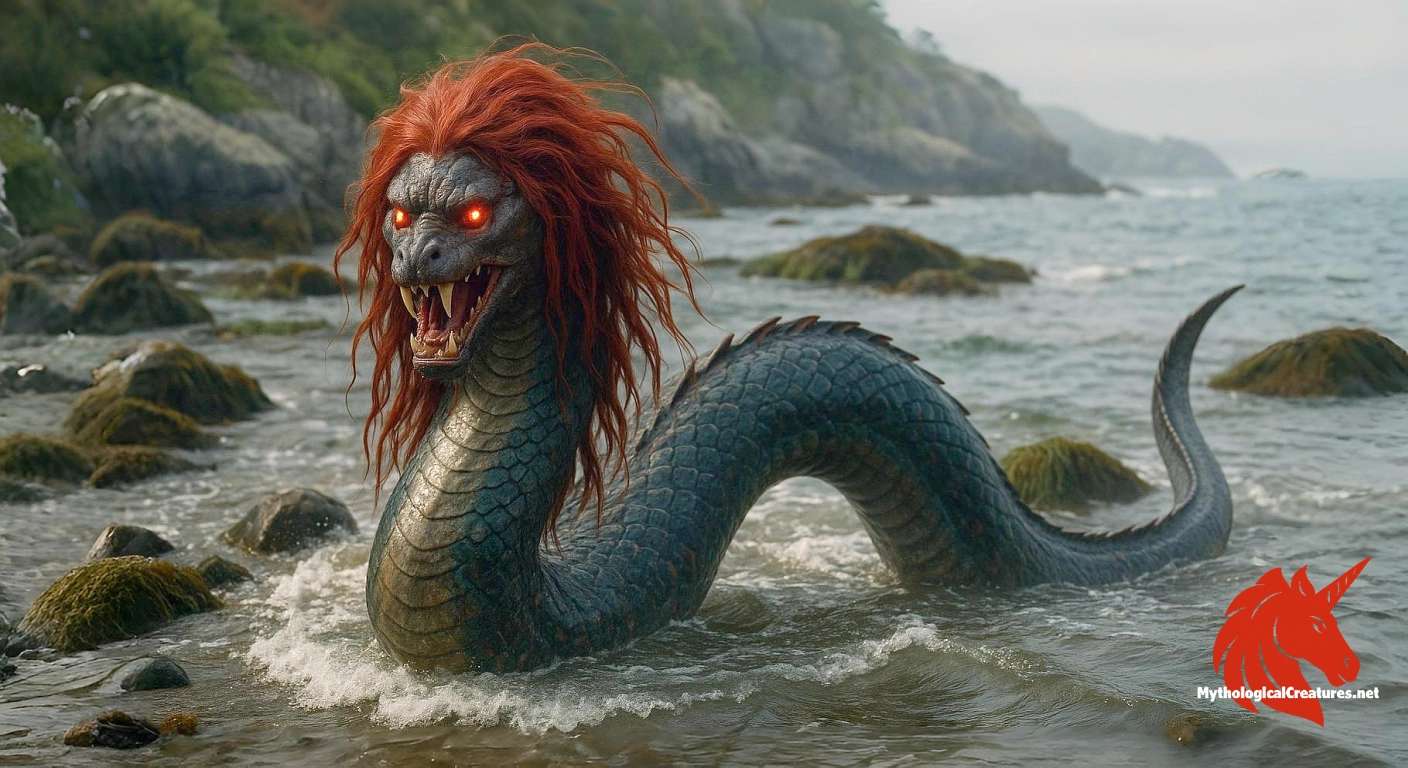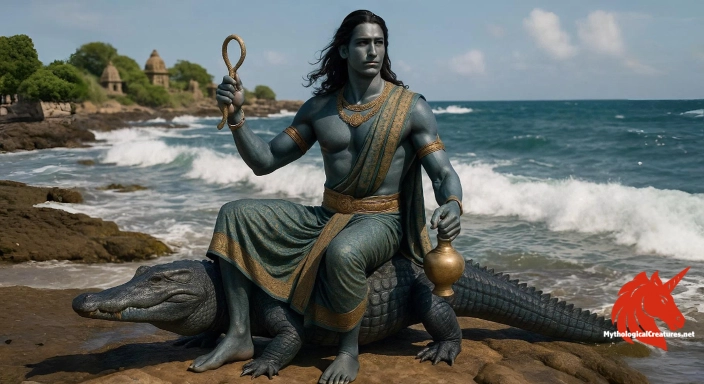Apotamkin: The Apotamkin is a giant, fanged sea monster from Native American mythology, hailing from Passamaquoddy Bay.

Apotamkin
Apotamkin - Used to instil caution in children and prevent them from entering dangerous waters or venturing onto thin ice unsupervised.
Origins & First Encounters
Deep within the rich oral traditions of Native American lore, Apotamkin emerges as a figure both frightening and protective, embodying the dual nature of the natural world. The creature is rooted in the cultural heritage of the Passamaquoddy people, where it has been recounted in stories that blend elements of caution and supernatural mystery. From its earliest attestation, Apotamkin has served as a potent symbol of the dangers lurking in the untamed waters, particularly in Passamaquoddy Bay. Its portrayal as a giant fanged sea monster is intricately interwoven with local beliefs, reflecting the community’s need to safeguard its young from peril. Intriguingly, some versions of the myth reveal that it was once a human woman, transformed into a serpentine beast by forces beyond mortal comprehension. This transformation not only heightens the creature’s enigmatic status but also underscores themes of metamorphosis and retribution. The myth, passed down through generations, wields influence as both a warning and a guardian spirit, demanding careful respect for nature’s unpredictable power. In its multifaceted role, Apotamkin represents the fine balance between life and danger, embodying a world where beauty and terror coexist in delicate harmony.
Source Texts & Tale Variants
Various oral traditions and early written accounts form the primary body of literature on Apotamkin, demonstrating its longstanding significance in Native American mythology. Early narratives, recounted by tribal elders, have preserved the creature’s tale as a living warning against the hazards of unsupervised play near dangerous waters. Different storytellers have introduced subtle variants, ranging from depictions of an unswerving predator to portrayals with protective overtones that deter children from the icy hazards of winter. Stories collected in folklore anthologies and settler records both highlight and embellish its monstrous attributes, thereby creating a tapestry of rich narrative strands. Some versions focus on its fanged, sea-dwelling nature while others emphasise its tragic origins as a woman transformed into a creature of the deep. These multiple storylines have allowed the myth to flexibly incorporate local experiences and moral lessons. Oral narratives and regional manuscripts continue to serve as invaluable sources that capture both the literal and allegorical dimensions of the legend. This blend of sources has fostered a dynamic tradition where the core elements of the myth persist even as details shift with time and context.
Form & Powers
Apotamkin is portrayed with a striking array of physical characteristics that set it apart as both alluring and abominable. The creature is often described as a gargantuan beast with immense fangs designed for predation, which lends it an air of relentless menace. One of its most distinctive features is the long, flowing red hair that cascades along its serpentine form, imbuing it with an almost human allure despite its monstrous nature. Its body, elongated and sinuous, is frequently depicted as both muscular and agile, suggesting a formidable ability to navigate the treacherous waters of its coastal domain. Variations in descriptions note that its skin may shimmer with a wet, reflective quality, hinting at scales interspersed with remnants of a human past. The creature’s eyes are often rendered as bright and penetrating, possessing a wild intelligence that adds to its eerie mystique. The overall size of Apotamkin is depicted as overwhelming, establishing it as an entity beyond the scale of ordinary sea creatures. Through these detailed physical portrayals, every element—from its lethal fangs to its vibrant hair—underscores both the beauty and brutality inherent in its design.
Regional Faces
The lore of Apotamkin is intimately tied to the coastal regions of northeastern America, particularly within the Passamaquoddy community, yet subtle regional nuances have shaped its portrayal. In the traditional narratives of this area, the creature is not merely a monster, but also a guardian figure that discourages risky behaviours near dangerous waters and thin ice. Variations in the myth often reflect local environmental challenges, with some communities emphasizing its role in preventing children from straying onto treacherous terrain. In neighbouring localities, different linguistic variations of its name underscore its adaptability within the regional oral tradition. The creature’s depiction can range from overtly malevolent to ambiguously protective, influenced by the specific cultural and geographical context of each retelling. These regional differences have allowed the myth to serve diverse functions, from a stark cautionary tale to a subtle instrument of community care. Local adaptations also modify details such as the texture of its scales or the intensity of its gaze, reflecting the unique interplay between nature and myth in these coastal settings. Through these evolving regional interpretations, Apotamkin remains a vital emblem of both local identity and the shared human instinct to mythologise nature’s dangers.
Cultural Parallels
The legend of Apotamkin finds rich parallels in similar mythological creatures from diverse cultures, highlighting a near-universal inclination to personify aquatic perils. Comparable figures such as the European sirens and mermaids share with Apotamkin a dual role as both seducers and harbingers of danger, though the latter’s narrative is more steeped in regional cautionary tradition. In many mythologies, beings emerging from the depths serve to warn against the seductions of the unknown, a role that Apotamkin fulfills by protecting children from the perils of unsupervised water exploration. This overlapping cultural motif underscores how disparate communities articulate fear and respect for the natural world through similar narrative devices. The transformation from human to beast, a prominent theme in Apotamkin’s story, resonates with other global folktales where metamorphosis is used to explain unexplained or tragic human phenomena. Comparative analysis reveals that while Apotamkin’s physical attributes and specific functions are uniquely rooted in Native American lore, its core narrative aligns with widespread traditions that employ monstrous appearances to deter recklessness. Such cross-cultural echoes affirm the myth’s universal appeal and its role in bridging the gap between local experience and broader mythological archetypes. In this way, Apotamkin stands as a compelling point of convergence between the unique cultural expressions of the Passamaquoddy and the enduring mythic themes found across the world.
Legacy & Modern Evolution
The legacy of Apotamkin has evolved significantly over time, transitioning from a strictly oral cautionary tale to a symbol that resonates in modern interpretations of indigenous myth. Historically, the creature served as a practical deterrent against dangerous behaviours among children, its fearsome legend ensuring that local customs valued vigilance near hazardous waters. Over the centuries, as the story was passed down and recorded in various formats, elements of the myth were reinterpreted to align with changing cultural and social narratives. Contemporary depictions often blend traditional fear with modern allegory, viewing the creature as both a monstrous embodiment of nature’s wrath and a poignant reminder of cultural heritage. Modern artistic renditions and literature have re-examined Apotamkin's dual legacy, sometimes portraying it sympathetically as a figure shaped by circumstances beyond its control. These reinterpretations are frequently seen in museum exhibits, local festivals, and literary works that seek to preserve and recontextualise indigenous folklore. The evolution of Apotamkin illustrates the dynamic interplay between myth and modernity, where ancient narratives continue to provide insight into human interaction with nature. Today, the story of the Apotamkin remains a vital part of cultural discourse, inspiring renewed interest in both the historical roots and contemporary significance of Native American mythology.
Interesting Fact
An intriguing aspect of the Apotamkin myth is that, while it is a terrifying monster designed to instil fear, it simultaneously functions as a guardian figure by enforcing safety among children in dangerous aquatic environments.
Quick Creature Info
Origin:
Associations:
Our Mythic Legendary Rating:

Also Sometimes Known As:
Habitat:
Supernatural Powers:
Physical Attributes:
Abilities:
Behavior:
Lore:
Related Creatures, Tales or Lore
References
Discover Another Mythical Legend You May Not Have Heard Of?
Uncover the mysteries of ancient folklore and expand your knowledge of legendary beings from cultures around the world.
Dare to Meet the Varuna....
Curated by the Mythological Creatures Team (rev. May 2025)
